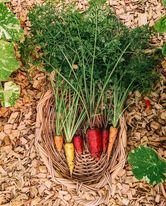A Case For Carrots
As summer draws to a close, many backyard gardeners are turning their attention to what to replace their summer crops with. While many gardeners have had difficulties with carrots, they can be an easy, rewarding vegetable that can be grown almost year-round across Australia. Best of all, they prefer sandy, slightly depleted soil which makes them a great follow-up to many of the nutrient- draining summer plants. Once you get the hang of them, they’re sure to become a staple.
Growing carrots at home gives you the benefit of being able to grow many varieties that are hard to find in supermarkets and produce stores. From purple to red to yellow and of course orange, they contain a range of nutrients such as vitamin A, B vitamins, antioxidants and both soluble and insoluble fibres that help maintain a healthy digestive system. They’re also super easy to eat and can be used raw, cooked or baked. Home-grown carrots also tend to taste better as they contain more natural sugars when freshly harvested.
Which colours will you grow this season?
If you’re looking at adding some carrot-y goodness to your garden, here are some helpful tips to get you started:
Choose soil that has a slightly sandy appearance and is fairly loose, in a position with plenty of sun. Compact, dense and rich soil will result in a poor-quality crop as the roots struggle to push through and the plant doesn’t need to reach for the nutrients it needs. Use a pitchfork or similar to loosen the soil without inverting it, removing any rocks and break up any soil lumps. The soil should feel soft.
Gently flatten out the top of the soil without compacting it (I like to use the back of the pitchfork). You can create shallow rows about 10-15cm apart using your finger to plant the seeds in if you prefer, use a marker to note where the rows are so you can water directly. Pinch the seeds between your fingers and sprinkle like you are seasoning a meal. You can plant different varieties together as long as their planting times match up. You will need fewer seeds than you think but if you go overboard don’t worry, it’s just a little extra thinning later.
Like most seeds, the carrot seeds need to be covered. Seed raising mix is a great way to do this without disturbing the seeds. Holding a handful of the seed-raising mix in your hands, rub them together to sprinkle the soil evenly as you release it through your fingers. This will create an even but thin layer of soil for the seeds to germinate in.
If you can, use a mist setting to gently water the seeds. A gentle shower is also ok. Keeping the soil moist for the first few weeks is key to a good germination, watering morning and night (and if possible at lunch on hot days) is important. Carrots can be slow to germinate and may take 2-3 weeks before showing signs of life. Keep watering and don’t lose hope.
Once the seedlings have started to grow adult leaves and are looking strong, you will need to thin them out before the root becomes too big. They need about 5cm between plants. While it may feel wrong to pull out so many healthy seedlings, the crop will be far better for it. At this point, you can also begin to reduce how often they are watered, with teenage to adult plants not needing much water at all (they prefer moist soil, watered every three days to once a week depending).
If you’re growing different varieties together, check the carrots regularly as some grow faster than others (particularly purple carrots). Gently dig around the carrot top and harvest the ones that seem the right size, leaving the smaller ones to continue to grow. Mature carrots can generally stay in the ground for a while, particularly in winter, though they may become slightly fibrous and bitter if left for too long.
With a little consideration of where to plant the seeds and how to care for the seedlings, growing carrots can be hugely rewarding (and delicious!). You would be surprised at how many carrots can be grown in a small space of less than a metre square. Planting heirloom varieties such as atomic red, cosmic purple and solar yellow also helps to add key nutrients to your diet and interest to your meals. Plus there are few things more satisfying than pulling out a homegrown carrot and having a crunch!











